Bulgogi recipe that has been my go-to family recipe for over 30 years!! This most popular Korean BBQ Beef dish is made from marinated thin slices of beef marinated in sweet garlicky soy sauce that is traditionally grilled over an open flame. Enjoy!

FEATURED COMMENT
“This is my go to recipe for bulgogi. I have been using it for a few years now and I highly recommend! 10 out of 10!” More Comments
Korean BBQ Beef or Bulgogi 불고기 literally means ‘fire 불 meat 고기’ in Korean. It is an amazing grilled Korean BBQ beef dish that will make anyone a fan of Korean food once you taste it. This is the very first recipe that I posted when I started my blog in 2010 and as I said in the title, I have been using this authentic recipe ever since – for 30 years which is basically how long I have been married. 😍
So this Authentic Bulgogi recipe has truly stood the test of time and I am still just as proud and confident about my recipe when I first posted it in 2010.
Table of Contents
What is Bulgogi
HISTORY – Bulgogi has its origins dating back thousands of years to the kingdom of Goguryeo (고구려 37 BC – 668 AD) which was in the form of beef grilled on skewers. Later in the 1800’s, with the introduction of metal grates, Koreans started to marinate thin cuts of beef and then grill on top of these gridirons. These were called Neobiahni Gui 너비아니 구이 which actually used thicker slices of beef than what is used today.
My most delicious memory goes way back to the days when my father took the whole family out to dinner at his favorite restaurant – Wooraeok 우래옥. You see the original owner of Wooraeok was a good friend of my father since they both fled North Korea during the Korean War in the ’50s.
Wooraeok still exists today in Seoul. They still cook the beef on the steel pan (see Seoul Bulgogi pic below) and my dad used to add rice and cracked an egg to the juice that accumulated around the rim. And OH MY…you will get a wonderful juk there.. I can still remember how good it tasted and I thought my dad was a genius!!
Best beef cut for Bulgogi?

Traditionally, top sirloin, tenderloin or rib eye cuts (like in the pic above) are considered to be the best cuts for bulgogi and they are thinly sliced across the grain. But if you don’t have a Korean grocery store near by, you can thinly slice a skirt or flank steak or even chuck roast against the grain. The more marbling the meat has, it will be more tender so try to buy meats that have good amount of marbling.
How to slice
Wrap the meat in plastic wrap and freeze it for 2 hrs or more (esp. if meat piece is bigger than 1 lb) and then take it out of the freezer and slice it thinly against the grain. Pro Tip – always sharpen your knife (like how chefs do on TV) before and it will be so much easier.
Substitutions for Bulgogi sauce Ingredients
Traditionally the marinade sauce is made from soy sauce (jin ganjang), mirin or cooking rice wine, Asian pear, garlic, sugar and/or honey, sesame oil, sesame seeds and black pepper.
Asian Pear is the traditional Korean tenderizer of choice for bulgogi recipes and the rule of thumb is 2 Tbs grated pear for 1 lb of meat. But if you don’t have it, you can certainly use other substitutes and it will be fine.
Substitute for Asian Pear
- Kiwi – this is my favorite tenderizer to use when a pear is not readily available – it’s so powerful that 1/2 kiwi is good for 5 lbs of beef so be careful not to use too much.
- Onion – 3 Tbs of minced onion will do its trick for 1 lb of beef
- Diet Coke – My go-to emergency fix is to add 2 Tbs of diet coke to 5 lbs of beef, if you find that the meat is still too tough even after the marinade. Use Diet Coke only as a last resort since it is very powerful and don’t leave it too long.
Substitute for Rice wine/Mirin
Rice wine/Mirin/Sake Substitute – Although most of the alcohol is cooked away when you cook, I get asked a lot whether they HAVE to use it. If you can’t use alcohol in your cooking, try the following: for 2 Tbs rice or red wine = 2 Tbs ginger ale OR 2 Tbs apple juice OR 4 tsp grape juice + 1 tsp wine vinegar + 1 tsp water. Also, reduce the amount of tenderizer (esp. kiwi) if using these since the acidity in these juices or ginger ale may have a slight tenderizing effect.
How to cook Bulgogi
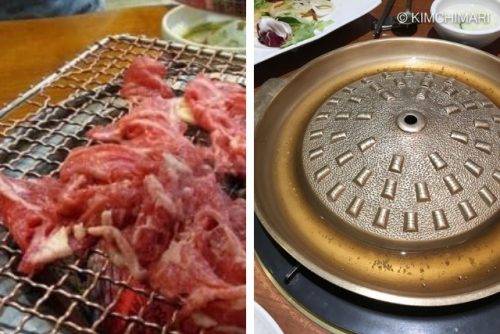
Pan Fry
It’s the easiest and simplest way to cook. The pan should be pre-heated on high heat and also don’t crowd the pan by adding too much bulgogi or you will end up with a lot of meat juice in the pan. But if you like bulgogi that has a lot of liquid, which you can mix your rice in (YUM!), then go ahead and cook slow on low heat.
GRILLING
The most authentic and traditional way to cook Korean BBQ (top left pic) is to cook it on an open flame on a charcoal grill or even a gas grill will do. Be sure to use either a fine steel mesh or tin foil to cook the meat over charcoal because otherwise, it will all fall through. You can also use tin foil on a grill and poke holes in them.
Broiling
You can also broil it on the top rack of your oven (Broil temp) but remember to keep a very close watch so it does not burn!
Bulgogi Pan over a gas burner
Traditional Bulgogi pan over Gas (see pic for Seoul Bulgogi) – Use the classic domed pan on top of a tabletop gas burner and cook with water or light broth added to the rim. The juice from the meat will fall into the water and later make a wonderful juice that you can mix with your rice. Add an egg and swirl it to make the juice even tastier!
FROM JINJOO!
Tips for Bulgogi
- Cook it well done – also tastes great if it’s caramelized and a little burnt…watch my video below to see how it is done.
- STORE leftovers (uncooked or cooked) in the fridge or the freezer. Just heat up in a frying pan. You can’t overcook bulgogi so it will still be good.
- SERVING Suggestions – Serve with some rice and Korean lettuce salad or with Ssam and Ssamjang. Slices of raw garlic or chili peppers can also be enjoyed in the Ssam or grilled together with your meat. More menu ideas in my Korean BBQ Dinner cookbook (subscribe to my blog 👉 receive a FREE copy!).
Seoul Bulgogi
Seoul Bulgogi (서울불고기) or sometimes called Yetnal Bulgogi (옛날불고기) is a variation of bulgogi that is made with the same marinated beef but it’s cooked either in a dome pan with a rim on the side that’s filled with water which then slowly gets turned into the most delicious broth as the meat juices drip down into the rim. Like so –
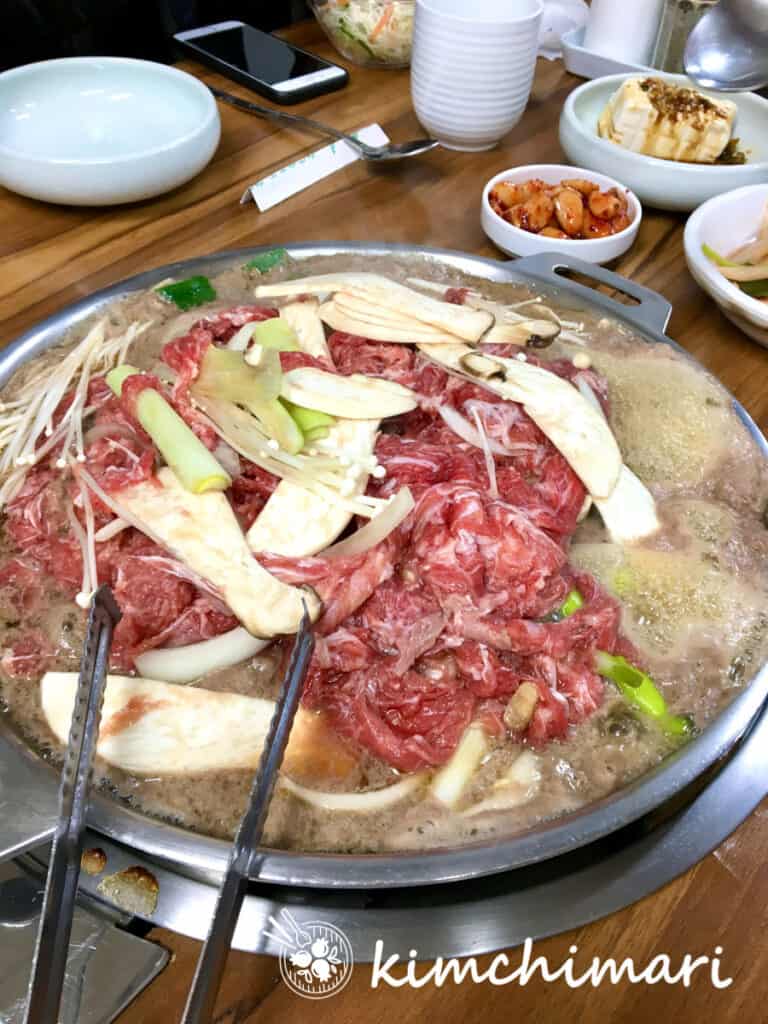
Or, it’s just all cooked in a pot with a broth and different vegetables like cabbage, mushrooms and Dangmyeon noodles. This also goes by Bulgogi Jeongol (stew) and here’s the pic below.

Different Korean Ssam Greens – I have a post that explains all the different greens you can use for ssam so mix them up!
Add-ons to Bulgogi
Traditionally, Koreans just marinate the beef by itself but you can add any or all of the following: sliced raw onions, mushrooms (shitake, white, oyster), bell peppers, carrots, green onions can all be added to pan when you cook the meat.
Step-by-Step Instructions
1. Make the sauce by mixing all of the marinade ingredients together except for any optional vegetables such as onions or mushrooms.
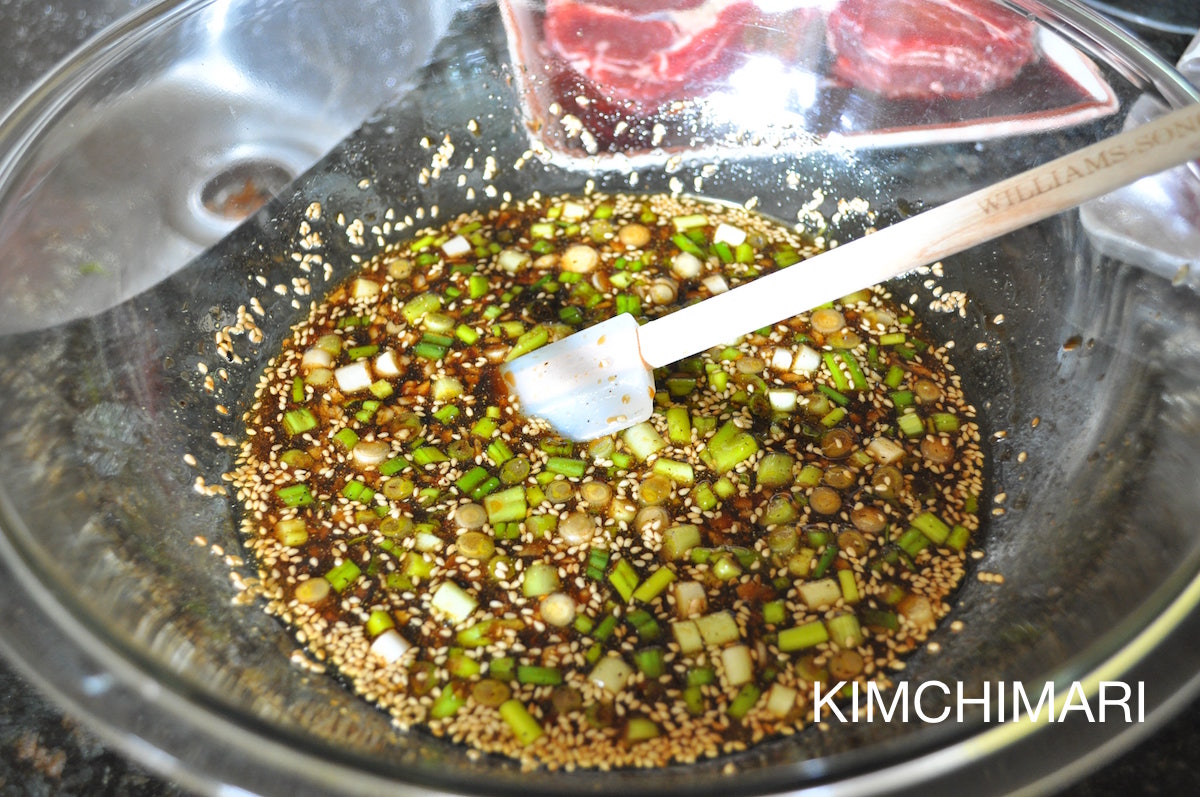
My favorite tenderizer to use is kiwi unless I have Asian pear at home (which I don’t always). I know it’s not traditional since kiwi is not a native Korean fruit but it really makes the meat melt in your mouth and much easier to buy outside of Korean groceries. Be careful not to use too much as it can actually make the beef almost crumble into nothing in your mouth.

2. Mix in the bulgogi beef into the sauce prepared above – in a bowl big enough to hold the beef. Make sure the sauce is well mixed with the beef. You will need to use your hands here and just massage everything together.
Make Ahead – and leave in the fridge overnight. Or if you are short on time (as is always the case with me.. ), making it just a few hours ahead works fine too. Even just 30 min. works. I’ve done that many times and most people don’t even seem to notice the difference. 🙂 But of course, it will taste better if you give it time to marinate and absorb all that good flavor.

3. COOK YOUR MEAT – (watch video too)
- STOVE TOP – Heat up your favorite frying pan on MEDIUM-HIGH heat and just pan fry/stir fry the meat until it’s slightly brown on both sides. Your pan should be hot enough so that the meat sizzles as it touches the pan. DON’T put too much meat into the pan and you will end up with a lot of the meat juice leaking out of the bulgogi which I personally don’t think is good. But some like a lot of juice so it’s your choice. Add any sliced vegetables to the pan about a minute after you start cooking the meat. Cook until meat is well cooked and caramelized (like you see below).
- OTHER – check my Tips above for other ways to cook.
And there you go!

NEW!! Watch and listen to my How to make Bulgogi video! Subscribe to my Youtube channel if you enjoyed it. 💕
If you have tried this recipe then please rate the recipe (☆☆☆☆☆ at the top right of the recipe card) and leave me a comment to let me know how you like it! 😍
You can also FOLLOW ME on FACEBOOK, PINTEREST and INSTAGRAM or join my FACEBOOK GROUP to ask and share everything about Korean food with others just like you! And also SUBSCRIBE to my Youtube Channel by watching the video and clicking on my logo on the right bottom of the screen.
XOXO ❤️
JinJoo
Bulgogi – Authentic Korean BBQ Beef Recipe
Ingredients
- 1 lb Thinly sliced sirloin (top sirloin or any tender loin area)
Marinade
- 3 Tbsp soy sauce
- 2 Tbsp light brown sugar [white sugar ok]
- 1 Tbsp honey [ 2 t sugar is also ok ]
- 2 Tbsp rice cooking wine or red wine [mirin works too]
- 1 Tbsp sesame oil
- 2 Tbsp minced garlic
- 1 tsp ground black pepper
- 2 tsp toasted sesame seeds
- 1 Tbsp chopped green onion
- 2 Tbsp pear, puree [ or 1 Tbs kiwi or 3 Tbs onion puree]
Instructions
- Make sauce by mixing all of the marinade ingredients together except for any optional vegetables such as onions or mushrooms.

- Mix in the bulgogi beef into the sauce prepared above – in a bowl big enough to hold the beef. Make sure the sauce is well mixed with the beef. You will need to use your hands here and just massage everything together.
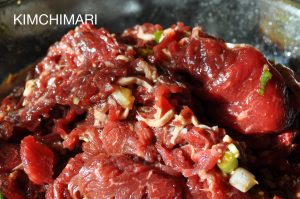
- Heat up your favorite frying pan on high heat and just pan fry/stir fry the meat until it’s slightly brown on both sides.

Tips & Notes:
- Marinating – marinate minimum 30 min at room temp (not too hot) or in the fridge for several hours up to 24 hrs. Freeze if you need it later than 24 hrs.
- kiwi substitute – 2 Tbs pear puree can be substituted with 1 Tbs kiwi.
- Pan should be hot enough so that the meat sizzles as it touches the pan. Also, if you put too much meat into the pan and/or the heat is too low, you will end up with a lot of the meat juice leaking out of the bulgogi and you end up with Bulgogi stew.
- The most authentic and traditional way to cook Bulgogi ( Korean Beef BBQ ) is on top of a charcoal grill- you will either need a fine steel mesh or tin foil to cook the meat because otherwise it will fall through. Bulgogi is supposed to be well cooked and tastes great if it’s a little burnt…
- You can also broil it on the top rack of your oven (Broil temp) but remember to keep a very close watch so it does not burn!
- Optional veggie ingredients – traditionally, Koreans just make bulgogi with beef by itself but if you are cooking it in a frying pan, you can add some sliced onions, mushrooms (shitake, white, oyster), bell peppers and even sliced carrots and cook them together.
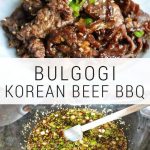

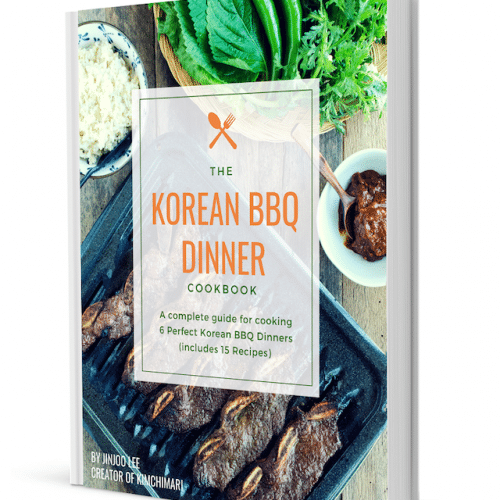
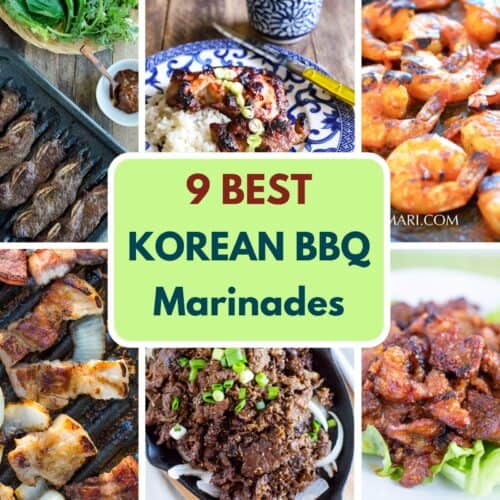
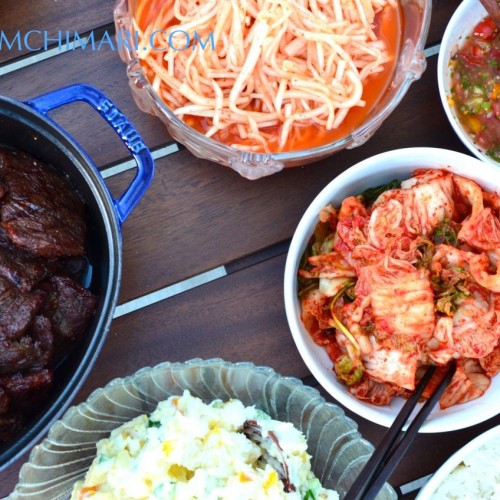















Hi there! I plan to use Asian Pear as a tenderizer. I will let the meat marinade overnight but when and for how long should I mix in the pear?
Hi! You should add it into the marinade from the beginning. Marinating overnight should be great. Hope I am not too late in replying! Thanks for asking.
Thank you for your reply! I was afraid if I let the pear marinade with the beef overnight that it might make the meat fall apart too much. I haven’t made it yet 🙂 I’m still looking for a good butcher since I’m not near any Korean markets. I miss the convenience when I “used to” live in LA.
Sure! Don’t worry. Pear is not as powerful as kiwi or coke. Overnight should be fine. Good luck!
I used to work for a Japanese company and I befriended a co-worker named Juko-son. She would invite me to dinner parties and I fell in love with Korean cuisine. I’m always looking for recipes that make the food taste authentic. I will be making Bulgogi as one of my dishes for my Christmas dinner and I used a fuji apple and a piece of papaya in my marinade, to tenderize the meat.
Hi Marian! I am sorry for the late reply as I was traveling until now. Thank you so much for trying my bulgogi recipe. And I would love to hear how it turned out for you – especially using Papaya!?? Happy New Year!!
I used to live in Cheongju, and no matter how many times I try, I can’t duplicate the amazing food. However, this recipe was easy and delicious. Thanks for the pear tip. I used a jar of pear baby food, and it worked perfectly.
Yay! So happy to hear that you liked my bulgogi recipe. I try to recreate the flavors of my childhood living in Korea so hopefully my recipes will be similar. Thanks so much for letting me know. Cheers!
How thinly should i say i want it at the meat department at the grocery store? I have 0 korean supermarkets near me.
So bulgogi can be made really paper thin slices (which will basically crumble when cooked) or can be made with slices that are as thick as a regular cardboard (not the double one) or about 5mm or 0.2 inches. I prefer to have my slices around that thickness. I think if you can ask for cuts for steak sandwich, that will work too. It works best when they use the deli meat slicer and when the meat is slightly frozen. But some may not want to use the deli slicer for raw meats. Anyway, hope it’s helpful!
I made this for my family today, and even my Autism-spectrum son loved it – and he has very few things he’ll actually eat. Adding something new to his diet is always a huge win. Thank you so much!
YAY!!! I’m SO happy to hear that your son loved it!! This really makes my day! Funny thing is we also had bulgogi today. 🙂 I actually stir-fried some onions and mini bell peppers and then had it together with the Bulgogi. It was so yummy together. Made a side lettuce salad with just a hint of rice vinegar, light sprinkling of salt, pepper, sugar and chili pepper. It all goes together so well. Rice was there of course. Thank you so much for letting me know!!
What does T mean???
Hi! T means Tablespoon. I have changed the abbreviation for you. Thank you so much for asking!